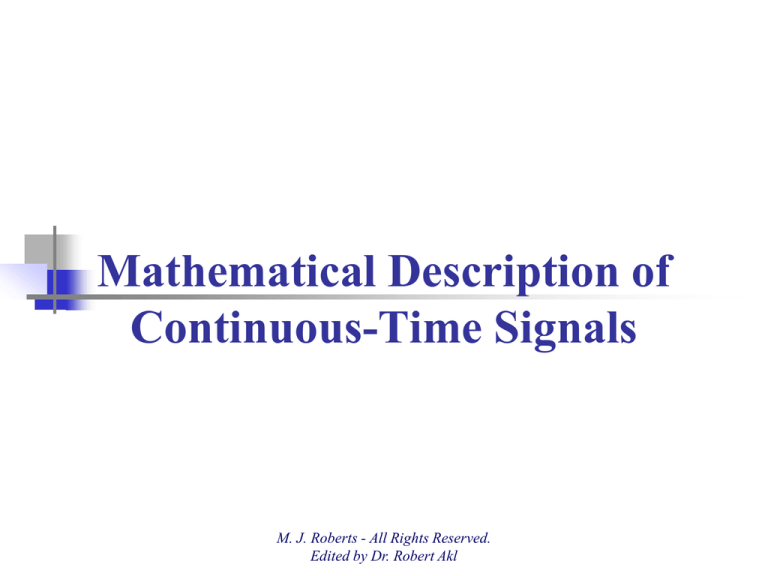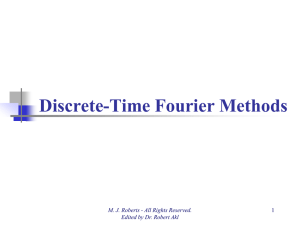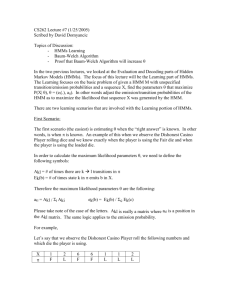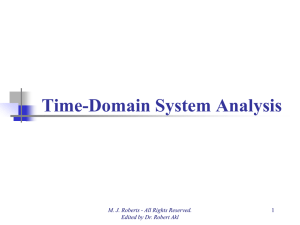
Mathematical Description of
Continuous-Time Signals
M. J. Roberts - All Rights Reserved.
Edited by Dr. Robert Akl
Typical Continuous-Time Signals
M. J. Roberts - All Rights Reserved. Edited by Dr. Robert Akl
2
Continuous vs Continuous-Time
Signals
All continuous signals that are functions of time are
continuous-time but not all continuous-time signals are
continuous
M. J. Roberts - All Rights Reserved. Edited by Dr. Robert Akl
3
Continuous-Time Sinusoids
()
(
)
(
)
(
g t = Acos 2p t / T0 + q = Acos 2p f0t + q = Acos w 0t + q
- Amplitude
Period Phase Shift
(s)
(radians)
Cyclic
Radian
Frequency
Frequency
( Hz)
(radians/s)
M. J. Roberts - All Rights Reserved. Edited by Dr. Robert Akl
)
4
Continuous-Time Exponentials
g ( t ) = Ae-t /t
- Amplitude Time Constant (s)
M. J. Roberts - All Rights Reserved. Edited by Dr. Robert Akl
5
Complex Sinusoids
M. J. Roberts - All Rights Reserved. Edited by Dr. Robert Akl
6
The Signum Function
ì 1 , t > 0ü
ï
ï
sgn ( t ) = í 0 , t = 0 ý
ï-1 , t < 0 ï
î
þ
Precise Graph
Commonly-Used Graph
The signum function, in a sense, returns an indication of
the sign of its argument.
M. J. Roberts - All Rights Reserved. Edited by Dr. Robert Akl
7
The Unit Step Function
ì1 , t > 0
ï
u ( t ) = í1 / 2 , t = 0
ï0 , t < 0
î
The product signal g ( t ) u ( t ) can be thought of as the signal g ( t )
“turned on” at time t = 0.
M. J. Roberts - All Rights Reserved. Edited by Dr. Robert Akl
8
The Unit Step Function
The unit step function can mathematically describe a
signal that is zero up to some point in time and nonzero after that.
()
()
i ( t ) = (V / R ) e
u (t )
v ( t ) = V (1- e
) u (t )
v RC t = Vb u t
-t / RC
b
-t / RC
C
M. J. Roberts - All Rights Reserved. Edited by Dr. Robert Akl
b
9
The Unit Ramp Function
ìt , t > 0 ü t
ramp ( t ) = í
ý = ò u (l ) dl = t u (t )
î0 , t £ 0 þ -¥
M. J. Roberts - All Rights Reserved. Edited by Dr. Robert Akl
10
The Unit Ramp Function
Product of a sine wave and a ramp function.
M. J. Roberts - All Rights Reserved. Edited by Dr. Robert Akl
11
Introduction to the Impulse
ì1 / a , t < a / 2
Define a function D ( t ) = í
, t >a/2
î0
Let another function g ( t ) be finite and continuous at t = 0.
M. J. Roberts - All Rights Reserved. Edited by Dr. Robert Akl
12
Introduction to the Impulse
The area under the product of the two functions is
a/2
1
A = ò g ( t ) dt
a - a/2
As the width of D ( t ) approaches zero,
a/2
1
1
lim A = g ( 0 ) lim ò dt = g ( 0 ) lim ( a ) = g ( 0 )
a®0 a
a®0 a
a®0
- a/2
The continuous-time unit impulse is implicitly defined by
g (0) =
¥
ò d ( t ) g ( t ) dt
-¥
M. J. Roberts - All Rights Reserved. Edited by Dr. Robert Akl
13
The Unit Step and Unit Impulse
As a approaches zero, g ( t ) approaches a unit
step and g¢ ( t ) approaches a unit impulse.
The unit step is the integral of the unit impulse and
the unit impulse is the generalized derivative of the
unit step.
M. J. Roberts - All Rights Reserved. Edited by Dr. Robert Akl
14
Graphical Representation of the
Impulse
The impulse is not a function in the ordinary sense because its
value at the time of its occurrence is not defined. It is represented
graphically by a vertical arrow. Its strength is either written beside
it or is represented by its length.
M. J. Roberts - All Rights Reserved. Edited by Dr. Robert Akl
15
Properties of the Impulse
The Sampling Property
¥
ò g ( t )d ( t - t ) dt = g ( t )
0
0
-¥
The sampling property “extracts” the value of a function at
a point.
The Scaling Property
1
d ( a ( t - t 0 )) = d ( t - t 0 )
a
This property illustrates that the impulse is different from
ordinary mathematical functions.
M. J. Roberts - All Rights Reserved. Edited by Dr. Robert Akl
16
The Unit Periodic Impulse
The unit periodic impulse is defined by
dT (t ) =
¥
å d ( t - nT )
, n an integer
n=-¥
The periodic impulse is a sum of infinitely many uniformlyspaced impulses.
M. J. Roberts - All Rights Reserved. Edited by Dr. Robert Akl
17
The Periodic Impulse
M. J. Roberts - All Rights Reserved. Edited by Dr. Robert Akl
18
The Unit Rectangle Function
ì 1 , t <1/ 2ü
ï
ï
rect ( t ) = í1 / 2 , t = 1 / 2 ý = u ( t + 1 / 2 ) - u ( t - 1 / 2 )
ï 0 , t > 1 / 2ï
î
þ
The product signal g ( t ) rect ( t ) can be thought of as the signal g ( t )
“turned on” at time t = - 1 / 2 and “turned back off” at time t = + 1 / 2.
M. J. Roberts - All Rights Reserved. Edited by Dr. Robert Akl
19
Combinations of Functions
M. J. Roberts - All Rights Reserved. Edited by Dr. Robert Akl
20
Shifting and Scaling Functions
Let a function be defined graphically by
and let g ( t ) = 0 , t > 5
M. J. Roberts - All Rights Reserved. Edited by Dr. Robert Akl
21
Shifting and Scaling Functions
Amplitude Scaling, g(t ) ® Ag(t )
M. J. Roberts - All Rights Reserved. Edited by Dr. Robert Akl
22
Shifting and Scaling Functions
Time shifting, t ® t - t 0
M. J. Roberts - All Rights Reserved. Edited by Dr. Robert Akl
23
Shifting and Scaling Functions
Time scaling,
t ®t /a
M. J. Roberts - All Rights Reserved. Edited by Dr. Robert Akl
24
Shifting and Scaling Functions
Multiple transformations
æ t - t0 ö
g ( t ) ® Ag ç
è a ÷ø
A multiple transformation can be done in steps
ætö
æ t - t0 ö
-t 0
/a
g ( t ) ¾ ¾¾¾
® Ag ( t ) ¾t®t
¾¾
® Ag ç ÷ ¾t®t
¾¾
® Ag ç
è aø
è a ÷ø
amplitude
scaling, A
The sequence of the steps is significant
æt
ö
æ t - t0 ö
-t 0
/a
g ( t ) ¾ ¾¾¾
® Ag ( t ) ¾t®t
¾¾
® Ag ( t - t 0 ) ¾t®t
¾¾
® Ag ç - t 0 ÷ ¹ Ag ç
èa
ø
è a ÷ø
amplitude
scaling, A
M. J. Roberts - All Rights Reserved. Edited by Dr. Robert Akl
25
Shifting and Scaling Functions
æ t - t0 ö
Simultaneous scaling and shifting g ( t ) ® Ag ç
è a ÷ø
M. J. Roberts - All Rights Reserved. Edited by Dr. Robert Akl
26
Shifting and Scaling Functions
Simultaneous scaling
and shifting, Ag ( bt - t0 )
M. J. Roberts - All Rights Reserved. Edited by Dr. Robert Akl
27
Shifting and Scaling Functions
M. J. Roberts - All Rights Reserved. Edited by Dr. Robert Akl
28
Shifting and Scaling Functions
()
((
) )
If g 2 t = Ag1 t - t0 / w what are A, t0 and w?
M. J. Roberts - All Rights Reserved. Edited by Dr. Robert Akl
29
Shifting and Scaling Functions
()
()
Height +5 ® -2 Þ A = -0.4 , g1 t ® -0.4 g1 t
()
( )
= -5 / 3 Þ -0.4 g ( 3t ) ® -0.4 g ( 3( t + 5 / 3))
Width +6 ® +2 Þ w = 1 / 3 Þ -0.4 g1 t ® -0.4 g1 3t
Shift left by 5/3 Þ t0
1
M. J. Roberts - All Rights Reserved. Edited by Dr. Robert Akl
1
30
Shifting and Scaling Functions
()
(
)
If g 2 t = Ag1 wt - t0 what are A, t0 and w?
M. J. Roberts - All Rights Reserved. Edited by Dr. Robert Akl
31
Shifting and Scaling Functions
()
()
Shift left 5 Þ t = -5 Þ -0.4 g ( t ) ® -0.4 g ( t + 5)
Width +6 to +2 Þ w = 3 Þ -0.4 g ( t + 5) ® -0.4 g ( 3t + 5)
Height +5 ® -2 Þ A = -0.4 Þ g1 t ® -0.4 g1 t
0
1
1
1
M. J. Roberts - All Rights Reserved. Edited by Dr. Robert Akl
1
32
Shifting and Scaling Functions
()
( (
If g 2 t = Ag1 w t - t0
)) what are A, t
M. J. Roberts - All Rights Reserved. Edited by Dr. Robert Akl
0
and w?
33
Shifting and Scaling Functions
()
()
Width +6 ® -3 Þ w = -2 Þ -0.6 g ( t ) ® -0.6 g ( -2t )
Shift Right 1/2 Þ t = 1 / 2 Þ -0.6 g ( -2t ) ® -0.6 g ( -2 ( t - 1 / 2 ))
Height +5 ® -3 Þ A = -0.6 Þ g1 t ® -0.6 g1 t
1
0
1
M. J. Roberts - All Rights Reserved. Edited by Dr. Robert Akl
1
1
34
Shifting and Scaling Functions
()
(
)
If g 2 t = Ag1 t / w - t0 what are A, t0 and w?
M. J. Roberts - All Rights Reserved. Edited by Dr. Robert Akl
35
Shifting and Scaling Functions
()
()
Shift Left 1 Þ t = -1 Þ -0.6 g ( t ) ® -0.6 g ( t + 1)
Width +6 ® -3 Þ w = -1 / 2 Þ -0.6 g ( t + 1) ® -0.6 g ( -2t + 1)
Height +5 ® -3 Þ A = -0.6 Þ g1 t ® -0.6 g1 t
0
1
1
1
M. J. Roberts - All Rights Reserved. Edited by Dr. Robert Akl
1
36
Differentiation
M. J. Roberts - All Rights Reserved. Edited by Dr. Robert Akl
37
Integration
M. J. Roberts - All Rights Reserved. Edited by Dr. Robert Akl
38
Even and Odd Signals
Even Functions
Odd Functions
g ( t ) = g ( -t )
g ( t ) = - g ( -t )
M. J. Roberts - All Rights Reserved. Edited by Dr. Robert Akl
39
Even and Odd Parts of Functions
g ( t ) + g ( -t )
The even part of a function is g e ( t ) =
.
2
g ( t ) - g ( -t )
The odd part of a function is g o ( t ) =
.
2
A function whose even part is zero is odd and a function
whose odd part is zero is even.
The derivative of an even function is odd and the derivative
of an odd function is even.
The integral of an even function is an odd function, plus a
constant, and the integral of an odd function is even.
M. J. Roberts - All Rights Reserved. Edited by Dr. Robert Akl
40
Even and Odd Parts of Functions
M. J. Roberts - All Rights Reserved. Edited by Dr. Robert Akl
41
Products of Even and Odd Functions
Two Even Functions
M. J. Roberts - All Rights Reserved. Edited by Dr. Robert Akl
42
Products of Even and Odd Functions
An Even Function and an Odd Function
M. J. Roberts - All Rights Reserved. Edited by Dr. Robert Akl
43
Products of Even and Odd Functions
An Even Function and an Odd Function
M. J. Roberts - All Rights Reserved. Edited by Dr. Robert Akl
44
Products of Even and Odd Functions
Two Odd Functions
M. J. Roberts - All Rights Reserved. Edited by Dr. Robert Akl
45
Integrals of Even and Odd Functions
a
a
-a
0
ò g ( t ) dt = 2 ò g ( t ) dt
a
ò g ( t ) dt = 0
-a
M. J. Roberts - All Rights Reserved. Edited by Dr. Robert Akl
46
Integrals of Even and Odd Functions
M. J. Roberts - All Rights Reserved. Edited by Dr. Robert Akl
47
Periodic Signals
If a function g(t) is periodic, g ( t ) = g ( t + nT ) where n is any integer
and T is a period of the function. The minimum positive value of T
for which g ( t ) = g ( t + T ) is called the fundamental period T0 of the
function. The reciprocal of the fundamental period is the fundamental
frequency f0 = 1 / T0 .
A function that is not periodic is aperiodic.
M. J. Roberts - All Rights Reserved. Edited by Dr. Robert Akl
48
Sums of Periodic Functions
The period of the sum of periodic functions is the least common
multiple of the periods of the individual functions summed. If the
least common multiple is infinite, the sum function is aperiodic.
M. J. Roberts - All Rights Reserved. Edited by Dr. Robert Akl
49
ADC Waveforms
Examples of waveforms which
may appear in analog-to-digital
converters. They can be
described by a periodic repetition
of a ramp returned to zero by a
negative step or by a periodic
repetition of a triangle-shaped
function.
M. J. Roberts - All Rights Reserved. Edited by Dr. Robert Akl
50
Signal Energy and Power
The signal energy of a signal x ( t ) is
¥
Ex =
ò x (t )
2
dt
-¥
M. J. Roberts - All Rights Reserved. Edited by Dr. Robert Akl
51
Signal Energy and Power
M. J. Roberts - All Rights Reserved. Edited by Dr. Robert Akl
52
Signal Energy and Power
é
æ t + 1ö ù
Find the signal energy of x ( t ) = ê 2 rect ( t / 2 ) - 4 rect ç
÷ø ú u ( t + 2 )
è
4 û
ë
¥
Ex =
ò x (t )
¥
2
dt =
-¥
ò
-¥
2
é
æ t + 1ö ù
ê 2 rect ( t / 2 ) - 4 rect çè 4 ÷ø ú u ( t + 2 ) dt
ë
û
¥
2
é
æ t + 1ö ù
Ex = ò ê 2 rect ( t / 2 ) - 4 rect ç
÷ø ú dt
è
4 û
-2 ë
¥
é
æ t + 1ö ù
2
2 æ t + 1ö
Ex = ò ê 4 rect ( t / 2 ) + 16 rect ç
÷ø - 16 rect ( t / 2 ) rect çè
÷ø ú dt
è
4
4 û
-2 ë
¥
¥
¥
æ t + 1ö
æ t + 1ö
Ex = 4 ò rect ( t / 2 ) dt + 16 ò rect ç
dt
16
rect
t
/
2
rect
dt
(
)
÷
ç
÷
ò
è 4 ø
è 4 ø
-2
-2
-2
1
1
1
-1
-2
-1
Ex = 4 ò dt + 16 ò dt - 16 ò dt = 8 + 48 - 32 = 24
M. J. Roberts - All Rights Reserved. Edited by Dr. Robert Akl
53
Signal Energy and Power
Some signals have infinite signal energy. In that case
It is more convenient to deal with average signal power.
The average signal power of a signal x ( t ) is
T /2
1
2
Px = lim
x ( t ) dt
T ®¥ T ò
-T /2
For a periodic signal x ( t ) the average signal power is
1
2
x
t
dt
(
)
ò
T T
where T is any period of the signal.
Px =
M. J. Roberts - All Rights Reserved. Edited by Dr. Robert Akl
54
Signal Energy and Power
A signal with finite signal energy is
called an energy signal.
A signal with infinite signal energy and
finite average signal power is called a
power signal.
M. J. Roberts - All Rights Reserved. Edited by Dr. Robert Akl
55
Signal Energy and Power
Find the average signal power of a signal x ( t ) with fundamental
period 12, one period of which is described by
x ( t ) = ramp ( -t / 5 ) , - 4 < t < 8
1
Px =
T
ò x (t )
T
8
2
0
1
1
2
2
ramp ( -t / 5 ) dt =
dt =
( -t / 5 ) dt
ò
ò
12 -4
12 -4
0
0 - ( -64 / 3) 16
1
1 t2
3
éët / 3ùû =
@ 0.0711
=
dt =
Px =
ò
-4
225
300
300
12 -4 25
0
M. J. Roberts - All Rights Reserved. Edited by Dr. Robert Akl
56











